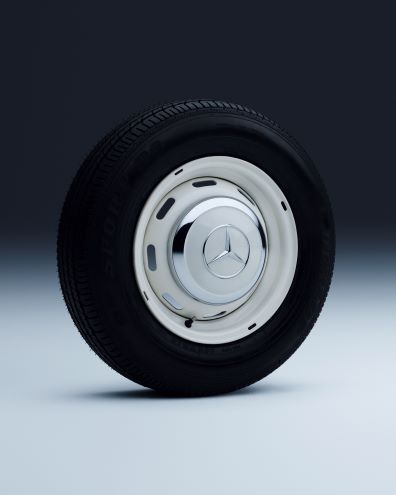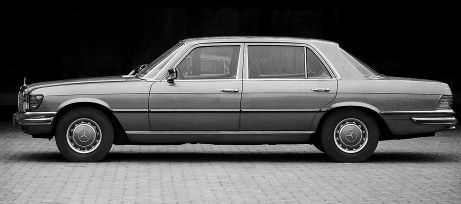
Wheels define the character of a vehicle and influence art and culture
Customers can choose from a wide range of wheels. In keeping with tradition, many designs follow overarching Mercedes themes. One example is the flat design, which can be found in various guises on Mercedes‑Benz, Mercedes‑AMG and Mercedes‑Maybach cars. Cross-spoke wheels in various configurations are just as much a part of the range as filigree multi-spoke models. Single, double or triple spokes enrich the programme. Different colours and polished surfaces set further accents. The ball-burnished surfaces of the forged wheels in the Mercedes‑Maybach model series represent the top end.
The first Mercedes moved the world on wheels with wooden spokes
The inventor of the motor car was also ahead of his time when it came to choosing wheels. Carl Benz built his patented motor car in 1886 on wheels with fine metal wire spokes. They dominated for many decades. It consisted of several parts and combined firmly bolted wooden spokes with a steel rim. The first Mercedes model drove from victory to victory at the 1901 race week in Nice on wheels with twelve wooden spokes each. This Mercedes 35 hp not only went down in history as a sensational sports car but is also widely recognised as the world’s first modern automobile.
Filigree wire wheels were popular in racing in the 1920s and 1930s
The lightweight yet robust wire-spoke wheels quickly became popular for sports cars. They were around 50 percent lighter than their robust wooden counterparts. For racing and record-breaking events, they were often fitted with sheet steel or aluminium covers. These “disc wheels” caused less air turbulence and therefore brought considerable aerodynamic advantages. One prominent example is the 200hp “Blitzen”‑Benz. In 1911, it was the fastest machine ever made, with a top speed of 228 km/h. Even aeroplanes and locomotives could not keep pace with it. The Blitzen Benz became a worldwide symbol of record-breaking achievement, and a legend that continues to have an impact to this day – even in art. In 1944, for example, the magazine “Esquire” published a series of racing illustrations by New York artist Peter Helck. Among others, it showed the then record-breaking driver Barney Oldfield at the wheel of the Blitzen‑Benz.
Coloured hubcaps and perforated trim rings: Icons of the 1950s boom and 1960s rock’n’roll
Beyond the flourishing motorsport sector, the sheet-steel disc wheel was used more and more frequently. It could be produced much more efficiently, and in large quantities. The pioneering 170 saloon from 1931 was the first to roll on these wheels. The design was crowned by small hubcaps with fine decorative lines, and proudly in each centre sat the Mercedes star. Various colours ranging from deep black to body colour as well as chrome-plated trim rings made it possible to fulfil individual customer wishes. Like their own footwear, customers could express themselves through their choice of wheels. Mercedes‑Benz further refined the design at the beginning of the 1950s. In addition to the hubcaps, perforated trim rings were added as a new design element. This gleaming chrome refinement celebrated its premiere in 1954 with the ‘Ponton‑Mercedes’ Type 220 (W 180) and the ambassadorial Mercedes‑Benz Type 300 b (W 186 III) saloon, the so-called “Adenauer‑Mercedes”. As the 1960s rolled around, the imperious Mercedes‑Benz 600 Pullman (W 100) also rode on these sheet-steel wheels. This iconic saloon was considered the best car of its time and was not only popular with state leaders – musicians such as John Lennon and Elvis Presley also drove the 600 Pullman.
The legendary 300 SL “Gullwing” Coupé, on the other hand, did not ride on pure-sheet-steel wheels. It was the first Mercedes‑Benz model with composite wheels. The wheel disc was made of steel, the rim of aluminium. Instead of five-wheel bolts, there was the option of a centre lock with a large wing nut as used in motor racing. With its iconic design, the 300 SL took people’s hearts and the cinema by storm. Its numerous celebrity owners included Hollywood stars Sophia Loren, Gina Lollobrigida, Tony Curtis and Clark Gable.
The SL became the dream car for the dream factory. It appeared in several films over many decades. Examples are “On the Beach” from 1959 with Gregory Peck, “The Betsy” from 1978 with Laurence Olivier and Robert Duvall, “The Rookie” from 1990 with Clint Eastwood, Charlie Sheen and Raul Julia, “Batman & Robin” from 1997 with Arnold Schwarzenegger and George Clooney, and “The Green Hornet” from 2011 with Seth Rogen and Christoph Waltz. Pop artist Andy Warhol elevated the 300 SL Gullwing to the Olympus of art in the 1980s with his “Cars” series. This sports car is a design icon and still enjoys cult status today.
“Baroque wheels” in iconic multi-spoke design powered the rebellious 1970s


